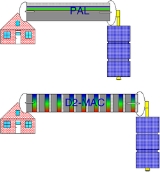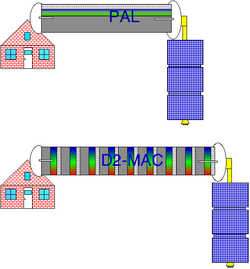
B-MAC
Encyclopedia


Multiplexed Analogue Components
Multiplexed Analogue Components was a satellite television transmission standard, originally proposed for use on a Europe-wide terrestrial HDTV system, although it was never used terrestrially.- Technical overview :...
(MAC) encoding. MAC encoding was designed in the mid 80s for use with Direct Broadcast Satellite systems. Other analog video encoding systems include NTSC
NTSC
NTSC, named for the National Television System Committee, is the analog television system that is used in most of North America, most of South America , Burma, South Korea, Taiwan, Japan, the Philippines, and some Pacific island nations and territories .Most countries using the NTSC standard, as...
, PAL
PAL
PAL, short for Phase Alternating Line, is an analogue television colour encoding system used in broadcast television systems in many countries. Other common analogue television systems are NTSC and SECAM. This page primarily discusses the PAL colour encoding system...
and SECAM
SECAM
SECAM, also written SÉCAM , is an analog color television system first used in France....
. Unlike the FDM
Frequency-division multiplexing
Frequency-division multiplexing is a form of signal multiplexing which involves assigning non-overlapping frequency ranges to different signals or to each "user" of a medium.- Telephone :...
method used in those, MAC encoding uses a TDM
Time-division multiplexing
Time-division multiplexing is a type of digital multiplexing in which two or more bit streams or signals are transferred apparently simultaneously as sub-channels in one communication channel, but are physically taking turns on the channel. The time domain is divided into several recurrent...
method. B-MAC was a proprietary MAC encoding used by Scientific-Atlanta
Scientific-Atlanta
Scientific Atlanta Inc is a Georgia-based manufacturer of cable television, telecommunications, and broadband equipment.Scientific Atlanta was founded in 1951 by a group of engineers from the Georgia Institute of Technology, and was purchased by Cisco Systems in 2005.-Products:Scientific Atlanta is...
for encrypting broadcast video services; the full name was "Multiple Analogue Component, Type B".
B-MAC uses teletext-style non-return-to-zero (NRZ) signaling with a capacity of 1.625 Mbit/s. The video and audio/data signals are therefore combined at baseband.
- Both PAL (626/50) and NTSC (525/60) versions of B-MAC were developed and used.
User base (PAL/NTSC zones)
- This system was used in Australia for TVRO until 2004.
- B-MAC has not been used for DTH applications since PrimestarPrimeStarPrimeStar was a U.S. direct broadcast satellite broadcasting company formed in 1991 by a consortium of cable television system operators. PrimeStar was the first medium-powered DBS system in the United States but slowly declined in popularity with the arrival of DirecTV in 1994 and Dish Network in...
switched to an all-digital delivery system in the mid-1990s.
MAC FAQ
MAC transmits luminance and chrominance data separately in time rather than separately in frequency (as other analog television formats do, such as composite video).Audio and Scrambling (selective access)
- Audio, in a format similar to NICAMNICAMNear Instantaneous Companded Audio Multiplex is an early form of lossy compression for digital audio. It was originally developed in the early 1970s for point-to-point links within broadcasting networks...
was transmitted digitally rather than as an FM subcarrier. - The MAC standard included a standard scrambling system, EuroCrypt, a precursor to the standard DVB-CSA encryption system.
See also
- Analog high-definition television systemsAnalog high-definition television systemsHistorically, the term high-definition television was first used to refer to a analog video broadcast television system developed in the 1930s to replace early experimental systems with as few as 12-lines. On 2 November 1936 the BBC began transmitting the world's first public regular...
- PALPALPAL, short for Phase Alternating Line, is an analogue television colour encoding system used in broadcast television systems in many countries. Other common analogue television systems are NTSC and SECAM. This page primarily discusses the PAL colour encoding system...
, what MAC technology tried to replace - SECAMSECAMSECAM, also written SÉCAM , is an analog color television system first used in France....
, what MAC technology tried to replace - A-MACA-MACA-MAC carries the digital information: sound, data-teletext on an FM subcarrier at 7 MHz. Since the vision bandwidth of a standard MAC signal is 8.4 MHz, the horizontal resolution on A-MAC has to be reduced to make room for the 7 MHz carrier...
- B-MAC
- C-MACC-MACC-MAC is the variant approved by the European Broadcasting Union for satellite transmissions. The digital information is modulated using 2-4PSK , a variation of quadrature PSK where only two of the phaser angles are used....
- D-MACD-MACAmong the family of MAC or Multiplexed Analog Components systems for television broadcasting, D-MAC is a reduced bandwidth variant designed for transmission down cable....
- E-MACE-MACE-MAC is 16:9 version of C-MAC. Originally E-MAC was designed for 15:9 pictures, it later adopted the 16:9 aspect ratio. The format is backwards compatible with C-MAC. It embeds additional information in field blanking and line blanking signals. E-MAC has a lower data capacity because of this...
- S-MAC
- D2-MAC
- HD-MACHD-MACHD-MAC was a proposed broadcast television systems standard by the European Commission in 1986 . It was an early attempt by the EEC to provide High-definition television in Europe. It was a complex mix of analogue signal , multiplexed with digital sound...
, an early high-definition television standard allowing for 2048x1152 resolution. - DVB-SDVB-SDVB-S is an abbreviation for Digital Video Broadcasting — Satellite; it is the original Digital Video Broadcasting forward error coding and demodulation standard for satellite television and dates from 1994, in its first release, while development lasted from 1993 to 1997...
, MAC technology was replaced by this standard - DVB-TDVB-TDVB-T is an abbreviation for Digital Video Broadcasting — Terrestrial; it is the DVB European-based consortium standard for the broadcast transmission of digital terrestrial television that was first published in 1997 and first broadcast in the UK in 1998...
, MAC technology was replaced by this standard
External links
- Multiplexed Analogue Components in "Analog TV Broadcast Systems" by Paul Schlyter

